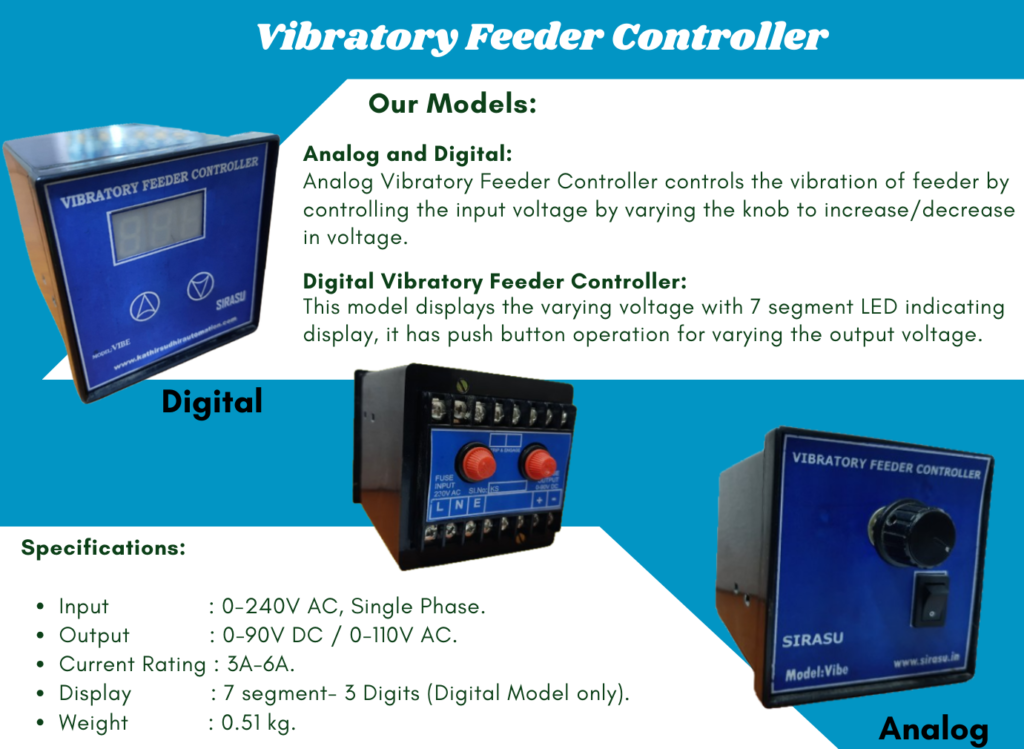In today’s fast-paced industrial landscape, automation and precision are of paramount importance. Vibratory feeder controller technology plays a pivotal role in achieving these goals by ensuring the efficient and controlled movement of materials within manufacturing processes. In this blog, we will delve into the fascinating world of vibratory feeder controller technology, exploring its mechanisms, applications, benefits, and the future it holds for various industries.

Understanding Vibratory Feeders
Before we dive into the specifics of controller technology, it’s essential to grasp the fundamentals of vibratory feeders. These ingenious devices are designed to transport bulk materials, parts, or components in a highly controlled and efficient manner. The heart of a vibratory feeder is a vibrating tray or bowl that generates continuous, smooth, and precisely controlled vibrations. These vibrations move the materials along the tray, ensuring a consistent flow.
The Role of Vibratory Feeder Controllers
Vibratory feeder controllers serve as the brains behind the operation. These controllers are responsible for managing and fine-tuning the vibrations of the tray, ensuring materials move at the desired rate and in the correct direction. Some key functions of vibratory feeder controllers include:
- Adjustable Settings: These controllers allow for precise adjustment of vibration frequency, amplitude, and direction, ensuring materials are transported with the required accuracy.
- Synchronization: In applications where multiple vibratory feeders are used in tandem, controllers can synchronize their operation to maintain harmony and optimize productivity.
- Monitoring and Feedback: Advanced controllers are equipped with sensors to monitor the material flow, enabling real-time adjustments to prevent clogs or irregularities.
- Remote Control: Many modern vibratory feeder controllers can be operated remotely, making it convenient for operators to make adjustments without direct physical access to the equipment.
Applications Across Industries
Vibratory feeder controller technology finds applications across a wide range of industries. Here are a few examples:
- Manufacturing: In the manufacturing sector, vibratory feeders are used to supply components to assembly lines, ensuring a smooth and continuous production process.
- Pharmaceuticals: Vibratory feeders are employed in pharmaceutical manufacturing to precisely dispense ingredients for drug formulation.
- Food Processing: In the food industry, vibratory feeders are utilized to convey and align food products for processing and packaging.
- Automotive: Vibratory feeders are crucial for conveying and orienting small components in automotive assembly processes.
- Mining and Construction: These feeders are used to transport bulk materials in mining and construction applications.
Benefits of Vibratory Feeder Controller Technology
The adoption of vibratory feeder controller technology brings several advantages to industrial operations:
- Improved Efficiency: Controlling the flow of materials enhances operational efficiency, reducing downtime and wastage.
- Consistency: Vibratory feeders ensure a consistent and reliable flow of materials, leading to higher product quality.
- Versatility: These systems can handle a wide range of materials, from tiny electronic components to large industrial parts.
- Labor Savings: Automation reduces the need for manual labor in material handling processes.
The Future of Vibratory Feeder Controller Technology
As technology continues to advance, so does the vibratory feeder controller technology. We can expect to see even more precise and adaptable controllers that integrate seamlessly with smart manufacturing systems. The use of artificial intelligence and machine learning may enable these controllers to optimize material flow autonomously and respond to changing production demands.
In conclusion, vibratory feeder controller technology plays a crucial role in modern industrial automation. Its ability to provide precise control over material handling processes contributes to increased efficiency, consistency, and productivity. With ongoing technological developments, we can only anticipate a brighter and more automated future for industries that rely on vibratory feeders.
